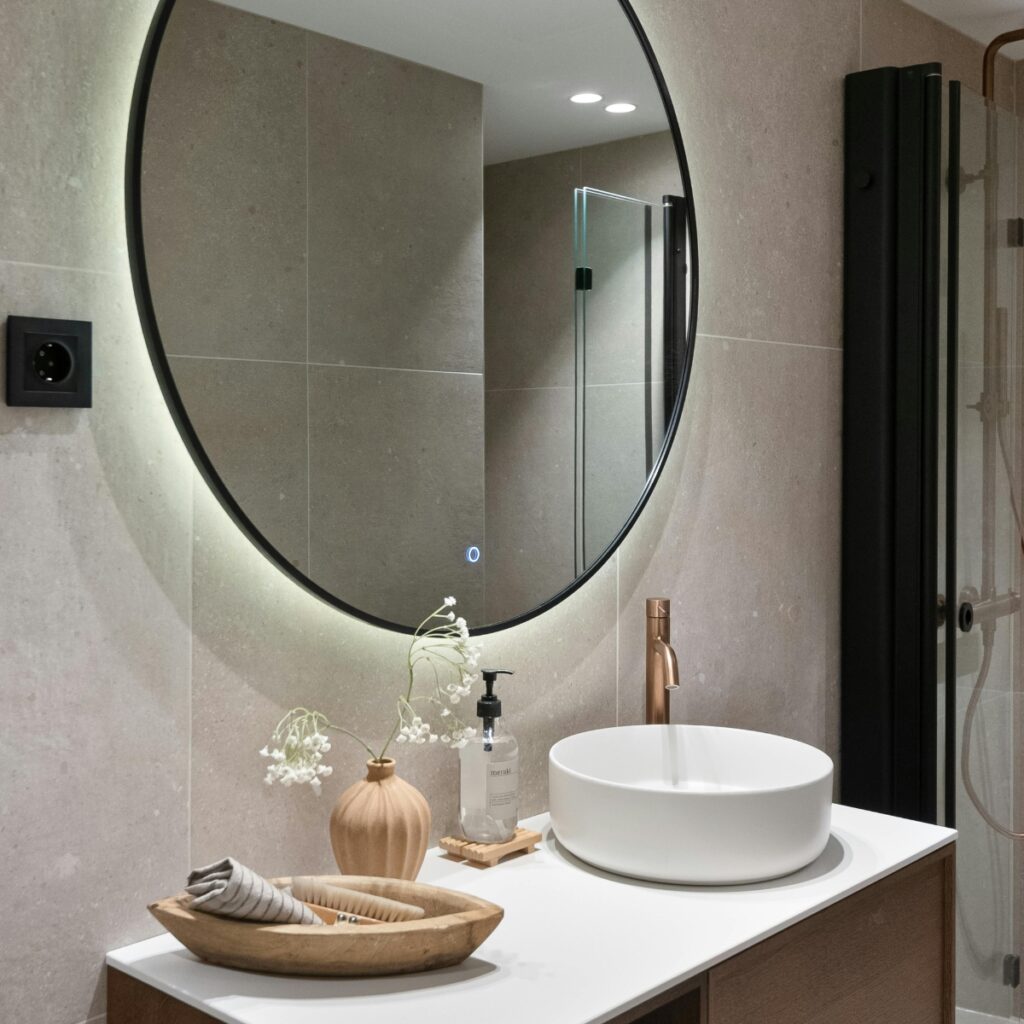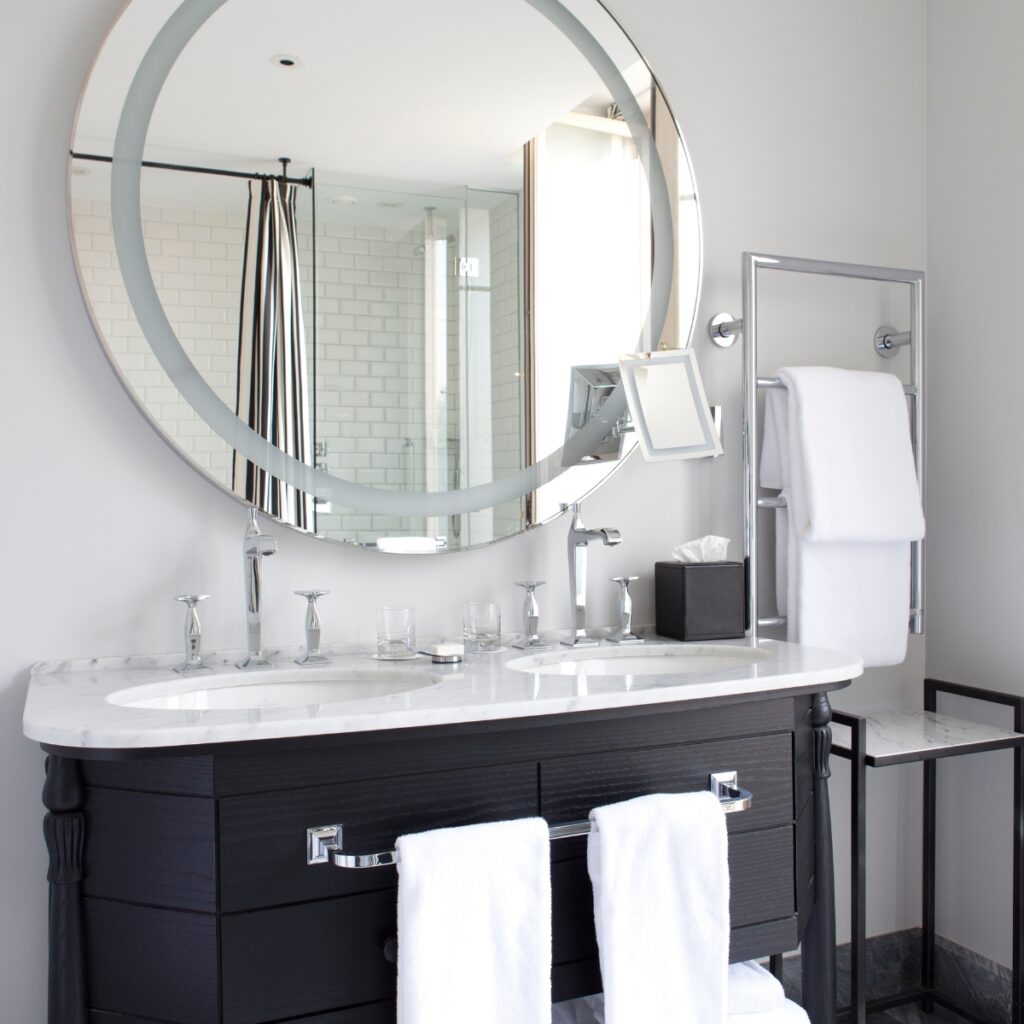
Choosing the perfect bathroom vanity is the cornerstone of any successful bathroom remodel or design project. Our comprehensive bathroom vanities buying guide helps you navigate every critical decision – from selecting the right size and materials to matching your preferred style. Whether you’re upgrading an existing space or designing a new bathroom, we answer all your essential questions about vanity measurements, storage solutions, trending colors, and installation considerations to ensure your selection enhances both functionality and aesthetics.
How Deep Is a Bathroom Vanity?
One of the most commonly asked questions is, “how deep is a bathroom vanity?” The depth of a bathroom vanity significantly affects both the functionality and layout of the room.
- Standard depth for most bathroom vanities is 21 inches from the front of the countertop to the back wall.
- Compact vanities—ideal for powder rooms or small bathrooms—typically range from 16 to 18 inches deep.
- For double sink vanities, depths may go up to 22-24 inches, especially in luxury master baths.
Keep in mind that depth includes both the cabinet and the countertop overhang. Always measure your bathroom space carefully before purchasing to ensure proper clearance for doors and walking space.
What Is the Standard Depth of a Bathroom Vanity?
The standard depth of a bathroom vanity is typically 21 inches, although it can vary slightly depending on the manufacturer and design style. This standard depth strikes the right balance between counter space and floor space, making it suitable for most residential bathrooms.
If your bathroom is small, you might opt for a narrow-depth vanity with a slimmer profile. However, going too shallow might compromise your sink’s usability or storage capabilities. Always check the depth when shopping to avoid last-minute surprises during installation.
How Tall Should a Bathroom Vanity Be?

Vanity height has evolved over the years. Traditionally, bathroom vanities were only 30 to 32 inches tall, making them accessible for children and aligning with older design norms. However, modern vanities now mimic kitchen counter heights, which are generally more ergonomic for adult use.
- Standard height: 32 inches
- Comfort height: 34 to 36 inches (also called “counter-height” vanities)
- Wall-mounted/floating vanities offer adjustable height depending on your installation preferences.
When choosing the right height, consider who will be using the bathroom most frequently. For shared or guest bathrooms, comfort height is often the best universal choice.
What Size Vanity for a 5×8 Bathroom?
A 5×8 bathroom is considered a standard-sized bathroom and provides some flexibility in vanity choices, depending on layout and the presence of a bathtub or shower.
- For such a space, a 24 to 36-inch wide vanity usually works best.
- If you want extra storage but still conserve space, consider a 30-inch vanity with drawers or a corner vanity to maximize floor area.
- Wall-mounted vanities are also an excellent space-saving option for small bathrooms.
Be sure to maintain at least 15 inches of clearance from the center of the toilet to the edge of the vanity, as per most building codes, to ensure comfort and functionality.
How to Replace Bathroom Vanity: Step-by-Step Guide
Knowing how to replace a bathroom vanity can save you hundreds of dollars on professional labor and give you the freedom to customize your design.
Here’s a step-by-step guide:
- Turn off the water supply. Shut off valves under the sink and disconnect plumbing.
- Remove the old vanity. Use a utility knife to cut any caulk sealing it to the wall and unscrew the unit.
- Prepare the area. Check for mold, water damage, or needed wall repairs.
- Mark and measure. Position your new vanity and mark the mounting holes.
- Secure the vanity to the wall. Use wall anchors or studs to fasten the unit securely.
- Install the sink and faucet. Secure the basin to the countertop and reconnect plumbing lines.
- Seal edges. Apply waterproof caulk around the edges and joints for a clean finish.
Pro Tip: If you’re switching from a floor-mounted to a wall-mounted unit, you may need to reroute plumbing or reinforce the wall studs.
What Is the Best Material for Bathroom Vanity?
When selecting a vanity, material choice plays a critical role in durability, maintenance, and overall aesthetic.
Top materials for bathroom vanities:
- Solid Wood: Offers premium durability and a high-end look, especially in oak, maple, or birch. Needs sealing for water resistance.
- MDF (Medium-Density Fiberboard): A budget-friendly option with good resistance to warping, especially when laminated.
- Plywood: More durable than MDF and resists moisture better, especially when used with veneer finishes.
- PVC or Plastic: Completely waterproof and highly resistant to mold and mildew, ideal for humid climates or budget-conscious buyers.
- Marble, Granite, Quartz (for countertops): These materials provide an elegant finish and are highly durable, although some require sealing to prevent staining.
Best overall material for most bathrooms is plywood or solid wood base with a quartz or granite countertop—balancing beauty, resilience, and longevity.
How to Decorate a Bathroom Vanity for Style and Function
A well-decorated vanity adds both charm and function to your bathroom space. Here’s how to decorate a bathroom vanity tastefully:
- Use trays or organizers to group essentials like soaps, perfumes, or toothbrush holders.
- Add greenery with small potted plants or succulents to bring life and freshness.
- Install stylish lighting like sconces or pendant lights for ambiance and task lighting.
- Incorporate mirrors with personality—frameless for minimalism or ornate frames for classic decor.
- Hang floating shelves above the vanity for added storage and visual interest.
- Use decorative jars and containers to store cotton balls, swabs, or bath salts.
Keep décor minimal and coordinated with your bathroom’s overall color palette to prevent visual clutter.
What Color Bathroom Vanity is in Style?
2025’s most popular bathroom vanity colors:
- Warm Whites (Antique White, Swiss Coffee) – Brightens small bathrooms
- Navy Blue – Pairs well with gold hardware and marble tops
- Sage Green – Creates spa-like serenity
- Charcoal Gray – Modern contrast with white countertops
- Natural Wood Tones (Walnut, Oak) – For organic modern styles
Pro Tip: Match your vanity color to existing tile grout for a cohesive look.
What are Bathroom Vanities Usually Made Of?
Common bathroom vanity materials:
- Solid Wood (Most durable; requires sealing)
- MDF/Plywood (Budget-friendly; moisture-resistant finishes)
- Metal (Industrial look; rust-proof coatings)
- Acrylic (Waterproof; modern glossy finishes)
- Concrete (Custom designs; needs annual sealing)
Countertops typically use quartz, marble, or porcelain.
What Are The Different Types Of Bathroom Vanity?
6 main bathroom vanity styles:
- Freestanding (Most common; easy installation)
- Wall-Mounted (Floating; ideal for small baths)
- Corner (Space-saving triangular designs)
- Double Sink (48-72″ wide; master baths)
- Vessel Sink Ready (No built-in countertop)
- Custom Built-In (Integrated with cabinetry)
What Is The Most Common Bathroom Vanity Size?
Standard bathroom vanity dimensions:
- Single Sink: 24-36″ wide x 21″ deep x 32-36″ tall
- Double Sink: 48-72″ wide x 21-24″ deep
- Small Bathroom: 18-22″ wide (Pedestal alternatives)
Height can be adjusted with furniture-style legs.
How Do I Add Storage to My Bathroom Vanity?
Storage solutions for existing vanities:
- Install stacked drawers instead of doors
- Add pull-out trays for deep cabinets
- Mount wall-mounted shelves above vanity
- Use door-mounted organizers (for makeup/brushes)
- Incorporate tiered countertop trays
How Much Space Should Be Between Side Wall and Bathroom Vanity?
Recommended clearances:
- Minimum: 2″ clearance on each side
- Ideal: 4-6″ for cleaning access
- ADA Compliant: 18″ minimum side clearance
Always measure your space before purchasing.
How to Measure Vanity Space Before Buying?
4-step measuring guide:
- Width: Measure wall space, subtracting 4-6″ clearance (minimum 2″ each side)
- Depth: Note distance from wall to nearest obstruction (toilet, door, etc.) – standard is 21″
- Height: For comfort, match to users’ wrist height (typically 32-36″)
- Plumbing: Measure drainpipe location (center should align with vanity drain)
Pro Tip: Use painter’s tape to mark the vanity footprint on your floor before purchasing.
How High Off the Floor Should a Floating Vanity Be?
Ideal floating vanity heights:
- Standard: 30-36″ (matches countertop height of floor-mounted vanities)
- Accessible: 34″ max for wheelchair users (ADA compliant)
- Modern: 27-30″ for vessel sinks (creates dramatic floating effect)
Consider these factors when deciding:
- User height (elbows should bend 90° at sink)
- Sink type (undermount vs. vessel)
- Storage needs (higher = more under-vanity space)
Conclusion
Choosing the right bathroom vanity involves much more than just picking a stylish piece. You must evaluate your space, lifestyle, plumbing setup, and aesthetic preferences. Whether you’re curious about how deep is a bathroom vanity, wondering how to replace bathroom vanity components yourself, or need to know what is the best material for bathroom vanity, having clear answers empowers you to make informed, confident decisions.
A well-chosen vanity doesn’t just elevate your bathroom’s look—it enhances your daily experience and long-term home value.

